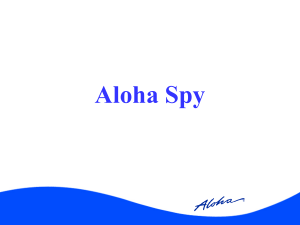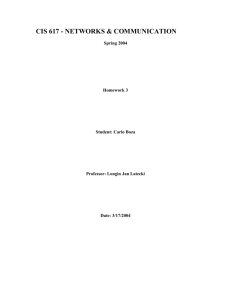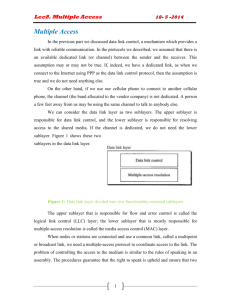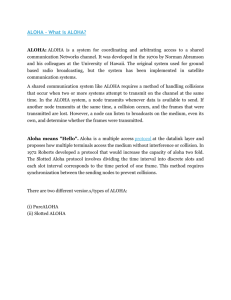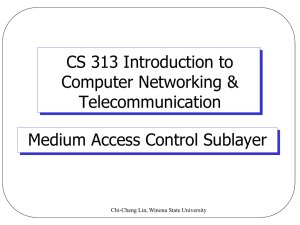POST HEARING STATEMENT - Florida Public Service Commission
advertisement
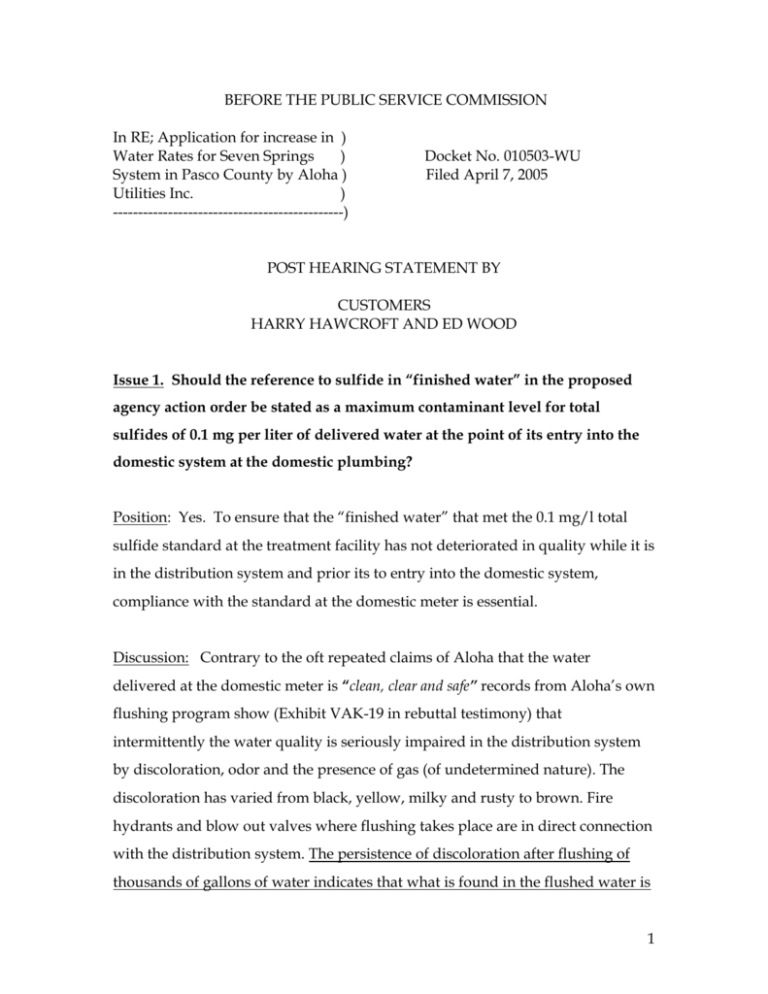
BEFORE THE PUBLIC SERVICE COMMISSION In RE; Application for increase in ) Water Rates for Seven Springs ) System in Pasco County by Aloha ) Utilities Inc. ) ----------------------------------------------) Docket No. 010503-WU Filed April 7, 2005 POST HEARING STATEMENT BY CUSTOMERS HARRY HAWCROFT AND ED WOOD Issue 1. Should the reference to sulfide in “finished water” in the proposed agency action order be stated as a maximum contaminant level for total sulfides of 0.1 mg per liter of delivered water at the point of its entry into the domestic system at the domestic plumbing? Position: Yes. To ensure that the “finished water” that met the 0.1 mg/l total sulfide standard at the treatment facility has not deteriorated in quality while it is in the distribution system and prior its to entry into the domestic system, compliance with the standard at the domestic meter is essential. Discussion: Contrary to the oft repeated claims of Aloha that the water delivered at the domestic meter is “clean, clear and safe” records from Aloha’s own flushing program show (Exhibit VAK-19 in rebuttal testimony) that intermittently the water quality is seriously impaired in the distribution system by discoloration, odor and the presence of gas (of undetermined nature). The discoloration has varied from black, yellow, milky and rusty to brown. Fire hydrants and blow out valves where flushing takes place are in direct connection with the distribution system. The persistence of discoloration after flushing of thousands of gallons of water indicates that what is found in the flushed water is 1 truly representative of what occurs in the distribution system. As far as the customers are aware, no tests for total sulfides or elemental sulfur or bacteriological evaluations have ever been undertaken at these sites. Chlorine residual levels that were done prior to the flushing have frequently demonstrated levels below the mandated FDEP minimum of 0.2mg/l and on many occasions and at a number of different sites have been documented to be zero (VAK-19). In spite of being aware of these deficiencies within its water processing and delivery system Aloha, contrary to facts from its own records, has represented to the regulatory agencies and customers that it has met the primary and secondary standards for water it delivers to the customers and that the requirements of FDEP disinfection threshold for chlorine residuals have been met (Mr. Porter’s testimony, page 11 lines1-7). The unwillingness of Aloha to test for total sulfides at the outlet of the domestic meter and demonstrate to the customers that the delivered water does not contain more sulfides than at the treatment facility indicates that the Utility is unable to guarantee that the “finished water” has not undergone deterioration of quality while still in the distribution system. Mr. Porter, Aloha’s expert is willing to admit that there is no correlation between a test done at the treatment plant and at a customer’s home (Transcript page 316, lines 2-6) but is unwilling to admit that such a lack of correlation could be due to the changes that occur in the distribution system, especially since “the water essentially could be as much as two to three days’ old”(Transcript page 317, line 23-24). “ So by the time I measure it here, and it shows a problem with the hydrogen sulfide level, it is too late. I have got a whole distribution system full of water now that doesn’t meet the standard”(Transcript page 317, lines 2-5). . On the basic scientific principle that reactions take place when and where conditions are appropriate, Aloha must admit that conditions existed within its processing, storage or distribution system that caused serious deterioration of water quality resulting in the 2 observations described in the flushing records. Instead to claim as Aloha has done that the deterioration of quality that produces copper corrosion or odor occurs exclusively in the domestic plumbing after Aloha has delivered “clean, clear and safe” water at the domestic meter is contrary to the evidence from its own records. Unless appropriate tests are carried out beyond the routine testing locations at points of entry into the distribution system, it is very easy to miss significant and relevant findings concerning what happens in the distribution system. It is true that tests for total sulfides done at delivery points during Dr Levine’s audit did not show levels of total sulfides in excess of 0.1 mg/l. However, the occurrence of a level of 0.12 mg/l of total sulfides in the inflow to the main tank, reported by Dr Levine as a major conclusion (Phase II audit Report, page iv) after the same water had only a level of less than 0.01 mg/l of total sulfides at the well sites (phase II audit report, pages 51, 53) demonstrates that such deterioration can occur and does occur even in the transmission system. To try to explain away this fact, Aloha expert Mr. Porter has created a new explanation of Aloha’s water processing. The theory is that some wells produce “partially treated” water (Direct testimony Mr. Porter, page 8, line 23) and that others presumably produce “fully treated” water! Closer examination shows that the processed water from wells 3 and 4 which Mr. Porter now claims was only “partially treated” met all the criteria Aloha maintains are necessary to establish that “finished water” has been adequately processed. On November 12, 2003 when the phenomenon of increase in hydrogen sulfide concentration was detected, water from wells 3 and 4 that was pumped into the storage tank contained less than 0.01 mg/l of hydrogen sulfide and had levels of free chlorine residual greater than the FDEP minimum of 0.2 mg/l, (Dr Levine’s Phase II 3 Report, Appendix B pages 51-54). What other criteria did the water not meet that justifies the water to be labeled “partially treated”? Further, Aloha would have to explain how it can control chlorination at wells in such a way that water is only “partially treated” and indicate that such a technique is being deliberately employed by Aloha at wells 3 and 4. However, “partial (or more accurately incomplete) treatment” can occur when stoichiometrically inadequate amounts of chlorine are added to the raw water, when the amount of total organic carbon is large or when pH is not adequately high such that the oxidation of hydrogen sulfide does not proceed all the way to sulfate. Aloha does not measure any of these water chemistry parameters at its wells on a routine basis. If the claim of Aloha is that such a method of “partial treatment” is being deliberately used by the Utility at well 3 and 4 from which water is pumped into the storage tank and subsequently additional amounts of chlorine are added as a “final treatment”, then Aloha must also concede that when hydrogen sulfide levels are very high in well 9 and only stoichiometrically inadequate amount of chlorine can be added water from well 9 is only “partially treated” because of the limitation of the maximum capacity of the chlorinator at that well (Dr Levine’s audit, Phase I report, page 20). The processed water from well 9 does not receive a second, final treatment before it is delivered to customers. Therefore customers must be receiving “partially treated” water from that well on a large number of occasions. If Aloha desires to be scientifically and logically consistent in its arguments about treatment outcomes with the sole use of chlorination, this fact must be conceded. Since the flushing data shows that intermittently water in the distribution system of Aloha is discolored, is odorous and contains gas and therefore is not stable, even if “adequately” treated at the treatment facilities, it is essential that the compliance to the standard be demonstrated at the point of delivery and not 4 only at the treatment facility. While it is true that the current method and any other oxidation method may be able to produce “finished water” that can meet the standard of 0.1mg/l of total sulfides at the treatment facility, the critical question is whether these methods are sufficiently robust to keep the water stable till it reaches the customers’ homes, sometimes 2-4 days later (Mr. Porter Transcript p. 317, lines 1, 24) and can maintain that stability in domestic plumbing for at least a reasonable time period after delivery. What other criteria are necessary to prevent deterioration of water quality and to document stability of water? If the way Aloha has been practicing the technical implementation of these methods result in the findings as reported in Aloha’s flushing records, then the totality of the processing and delivery system must be held to be inadequate to deliver stable water of good quality. Whether the standard is called a maximum contaminant level or is designated instead as a ‘goal ‘or a ‘performance standard’ is immaterial to the customers and their welfare as long as the same identical level is used for compliance certification at the point of delivery to the customers and is also an action level (as TBWA does – Exhibit VAK-26). What is important is that the standard be complied with at the point of delivery to the customers with actions taken to correct deficiencies as soon as such failure of compliance is detected. To do so, compliance has to be checked at the domestic meter. This is merely part of excellent process control and system management one must expect of any drinking water utility. One cannot blame the deterioration of water quality (black water and rotten egg smell) on water chemistry hypothesized to occur exclusively within the domestic plumbing unless compliance was demonstrated at the point of delivery. Such deterioration of water quality could have occurred anywhere between the treatment facility and the domestic plumbing and the evidence provided by Aloha’s own flushing records is that it does occur in Aloha’s distribution system, even though Aloha has avoided reporting such 5 events to regulatory agencies and is unwilling to admit that such events do take place. So the observation of the customers that the delivered water intermittently is not “clean, clear and safe” is not a hypothesis, but a proven fact. Aloha, instead of taking immediate action in such situations has adopted a very cavalier and negligent approach. To quote from Aloha’ s own flushing records, on Tuesday, November 9, 1999 the footnote says, “Tony, said to check Friday for next schedule to see if still discolored” (page 39, VAK-19). Even a layperson would know that the naked eye appearance of water as ‘clear’ is no guarantee that it is “clean or safe”; how much more likely is water not clean and not safe when water is discolored and smelly as reported by Aloha technicians! If on the other hand, there was no deterioration of quality within the domestic system in which plumbing material meets all national standards for such material and normal daily use of water does take place, then one could certainly deduce that the processed water had met standards at the point of delivery also. The widespread inability to provide stability of water in the transmission and distribution system points to either an inherent weakness in the current method, namely its easy reversibility and tendency to produce elemental sulfur, and/or the inadequacy of facilities that result in inability to add the necessary amount of oxidant or the inadequate maintenance of facilities and the distribution system. In this context it is not only illogical, but also negligent to postulate a theory of causation for black water and rotten egg smell exclusively confined to domestic plumbing as Aloha has done for almost a decade and claim it as a fact. A more robust method of processing and a commitment to remove causative antecedent factors such as elemental sulfur and regenerated hydrogen sulfide become a more appropriate and mandatory response under these circumstances. In the absence of an ability or willingness on the part of Aloha to expel (rather than oxidize) hydrogen sulfide from raw water or filter off the intermediate oxidation byproduct of elemental sulfur from “finished water”, conformity to standard by compliance certification at the domestic meter becomes the minimum essential 6 requirement of proper system management. There is no legitimate way to circumvent this scientific necessity. Issue 2: Should the improvements be such that sulfide present in raw water or generated during treatment and transmission be removed, not converted, to a level not to exceed 0.1mg/l in finished water delivered at the point of entry into the domestic system? Position: Yes. The reason for imposing stringent standards results from the inability of the processing method and its technical implementation as practiced by Aloha to produce stable water in the distribution system and the domestic plumbing. This logic also applies to the new method contemplated by Aloha for future use. Discussion: Aloha has not provided any evidence to show that the method that it uses now and intends to use in the future is capable of producing “finished water” that remains stable in the distribution system. Close to 30% of Aloha customers complained of problems with discoloration of water in domestic plumbing during a survey in 1998. A recent survey done in November 2004 by the PSC showed that the percentage remains essentially the same to this day. Aloha has responded to these statistics by ignoring them or underreporting them and by claiming that deterioration of water quality is exclusively confined to domestic plumbing. Evidence cited in Issue 1 discussion shows that such is not the case. Aloha has also put forward the hypothesis that deterioration in domestic plumbing is due to removal of chlorine by water softeners, but the Pasco County Black Water study conducted by FDEP and cited by Dr Kurien in his rebuttal testimony (Rebuttal testimony VAK-20) showed that there is no validity to this hypothesis because the frequency of black water was similar irrespective of the presence or absence of water softeners. On the other hand, Dr 7 Levine and Mr. Porter, the experts of Aloha in these proceedings, as well as other water processing experts concur that presence of elemental sulfur in finished water can diminish its disinfection capability (Direct testimony Dr Kurien VAK-6 & VAK-7) Such a situation can be associated with black water and production of rotten egg smell due to the activity of sulfur reducing bacteria, an anaerobic organism present in delivered water. Dr Levine and Mr. Porter have conceded that elemental sulfur is formed in Aloha’s wells, even though precise quantification of its extent is impossible at the present time. For the control of copper corrosion and black water FDEP guidelines emphasize the need to remove elemental sulfur from finished water if chlorination alone is used to process water and hydrogen sulfide level in source water is higher than 0.3mg/l. Even though as a legal reality Aloha’s wells are grandfathered under this rule (Mr. Sowerby, Transcript, page 263, lines 13-17), as a scientific and practical reality such legal provisions do not change the chemistry of finished water from Aloha’s wells. All of Aloha’s wells contain more hydrogen sulfide than this threshold level of 0.3mg/l at least intermittently and some of the wells always contain hydrogen sulfide levels much higher than this threshold (Dr Levine’s Phase II report, page 18). Therefore removal of almost all hydrogen sulfide (cf. the 98% removal standard in the PSC order of 2002) or removal of elemental sulfur produced during processing is an essential necessity for control of copper corrosion and black water as stated in the FDEP guidelines. The experience of nearby utilities show that along with appropriate adjustment of pH and the removal of hydrogen sulfide by the use of aeration methods or by the removal of elemental sulfur as recommended by the F.A.C. Rule 62-555.355 (5) (Mr. Sowerby, Transcript Page 253, lines10-14), “finished water” can be made more stable. Any oxidation process, including the use of hydrogen peroxide that attempts to convert all of the hydrogen sulfide in raw water to sulfate but does not succeed will not significantly reduce the incidence of black water and rotten egg smell in the domestic plumbing. A significant reduction of black water and 8 an improvement in water quality in the domestic plumbing were the purpose of the April 2002 PSC Order that was challenged by Aloha, but was upheld by the District Court of Appeals. Hence this amendment also must be included in any rewording of the 98% removal standard. Issue 3: Should compliance with such requirements be determined based upon samples taken at least once a month at a minimum of two sites at domestic meters most distant from each of the multiple treatment facilities. Should sites be rotated to provide the greatest likelihood of detecting any departure from the maximum levels permitted? Position: Yes. However customers recognize the need for flexibility concerning the frequency with which and the number of sites at which compliance has to be certified and are willing to consider adjustments as long as the customers are consulted before any change is made. Discussion: The drinking water that Aloha distributes now comes from 8 different wells. The hydrogen sulfide levels in these wells have varied from 0.1 mg/l in February 2001 at well 1 to 6.71 mgs/l at well 9 in May 2001 (Phase I audit report, page 10). Elemental sulfur is produced intermittently in the processed water from a number of wells. Soon Aloha will receive aerated water from Pasco County Utility without a guarantee that the sulfide level will meet Aloha’s own standard of 0.1mg/l. “This mixing of Pasco County (Tampa Bay Water) bulk finished water supply with Aloha water in the distribution system would produce a combined water that would not reflect the quality of water produced by Aloha’s own facilities if taken alone” (Mr. Porter, testimony page 5, lines 20-23). When these 9 sources of processed water are introduced into a common manifold without appropriate and adequate blending in a centralized tank, further significant variability and instability can occur. Therefore the 9 amendment stated in Issue 3 is not inappropriate and is essential in the initial stages when a new method is installed and a new source of water is added to the mix. The frequency with which and locations within the distribution system at which compliance has to be certified beyond the basic requirement in Issue 1 that it be accomplished at the point of delivery, is a function of the method of processing used, the excellence of process control and the efficacy of system management which in turn includes adequacy of facilities and the maintenance of hygiene in the infrastructure that distributes processed water. There could be situations in which the frequency and locations for compliance certification need to be revised upwards or downwards taking into consideration the realities of every day performance by the utility. Normally this would be the province of the utility and constitute what is properly called process control and system management. The history of Aloha’s unwillingness to address these responsibilities (VAK-19) so that delivered water remains stable in domestic plumbing will always remain a red flag for its customers to remain vigilant about compliance certification. Customers who pay for O&M costs through rate increases should have an important voice in the maintenance of water quality, because they are the ones who will notice variations in water quality well before the Utility is likely to admit such occurrences. Customer complaints in this area will have to be monitored by customer representatives with powers to examine Aloha’s operating records. This is necessary because of Aloha’s consistent refusal to share information with its customers. The FDEP and PSC are remote and have not been effective in their supervision of the utility’s day-to-day performance in relation to water quality during the last ten years. 10 After the institution of appropriate and frequent measurement of water chemistry parameters through automated feed back information loops as envisaged, the Utility may be able to convince its customers through their representatives that excellent process control has been achieved and system management is efficiently and consistently maintained. If such improvement in process control results in increased stability of water in the distribution system as demonstrated by consistent compliance certification at delivery points and reduction in customer complaints, it will be appropriate to reduce the number of sites and frequency of tests for compliance. On the other hand, any deterioration in water quality should result in more aggressive compliance enforcement to maintain the quality and stability of water. The subjective assessments of customers of Aloha are essential for this process to become effective, because discoloration of water and rotten egg smell are more sensitive than even the standards that are being recommended at this time. On the other hand, an adequate minimum of objective compliance measurements at the point of delivery will prevent subjective complaints of customers from holding the utility captive to non-provable claims of poor quality. When necessary the matter can be referred to the FDEP and PSC for further enforcement action. s/ Harry Hawcroft Harry Hawcroft, 1612 Boswell Lane New Port Richey, Fl 34655 s/ Ed Wood Ed Wood 1043 Daleside New Port Richey, FL 34655 11 DOCKET NO. 010503-WU CERTIFICATE OF SERVICE I HEREBY CERTIFY that a copy of the foregoing has been furnished by U. S. Mail or hand-delivery to the following parties on this 7th day of April, 2005. s/ Charles J. Beck Charles J. Beck Rosanne Gervasi, Esquire Division of Legal Services Fla. Public Service Commission 2540 Shumard Oak Blvd. Tallahassee, FL 32399-0850 F. Marshall Deterding, Esquire John Wharton, Esquire Rose, Sundstrom and Bentley, LLP 2548 Blairstone Pines Drive Tallahassee, FL 32301 Mr. Harry Hawcroft 1612 Boswell Avenue New Port Richey, FL 34655 V. Abraham Kurien, M.D. 7726 Hampton Hills Loop New Port Richey, FL 34654 Edward O. Wood 1043 Daleside Lane New Port Richey, FL 34655 Senator Mike Fasano 8217 Massachusetts Avenue New Port Richey, FL 34653 Aloha Utilities, Inc. Mr. Stephen G. Watford 6915 Perrine Ranch Road New Port Richey, FL 34655-3904 John H. Gaul, Ph.D. 7633 Albacore Drive New Port Richey, FL 34655 Wayne T. Forehand, Chairman Citizens’ Advisory Committee 1216 Arlinbrook drive Trinity, FL 34655-4556 James Mitchell, Jr. Riviera Home Owners Association 5957 Riviera Lane New Port Richey, FL 34655 12 Ann Winkler Riverside Village Estates, Unit 4 4417 Harney Court New Port Richey, FL 34655 John Parese Riverside Villas 4029 Casa del Sol Way New Port Richey, FL 34655 Jack Shreve, Esquire Office of Attorney General PL-01, The Capitol Tallahassee, FL 32399-1050 13

